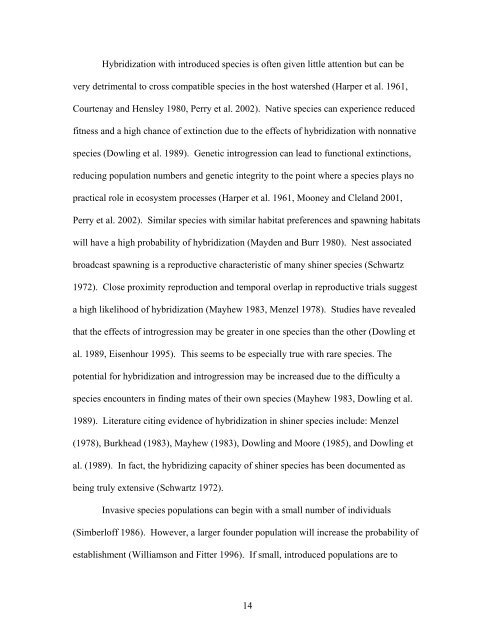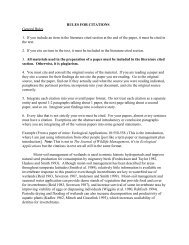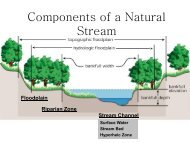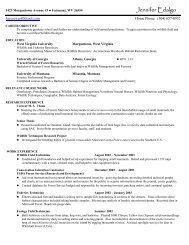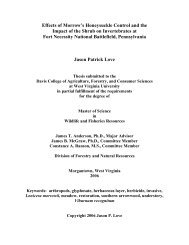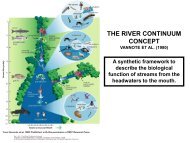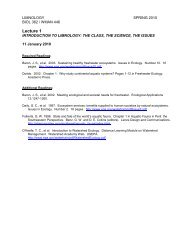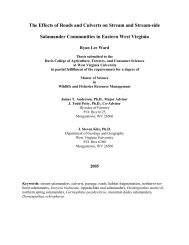An Experimental Study of Vertical Habitat Use and Habitat Shifts in ...
An Experimental Study of Vertical Habitat Use and Habitat Shifts in ...
An Experimental Study of Vertical Habitat Use and Habitat Shifts in ...
You also want an ePaper? Increase the reach of your titles
YUMPU automatically turns print PDFs into web optimized ePapers that Google loves.
Hybridization with <strong>in</strong>troduced species is <strong>of</strong>ten given little attention but can be<br />
very detrimental to cross compatible species <strong>in</strong> the host watershed (Harper et al. 1961,<br />
Courtenay <strong>and</strong> Hensley 1980, Perry et al. 2002). Native species can experience reduced<br />
fitness <strong>and</strong> a high chance <strong>of</strong> ext<strong>in</strong>ction due to the effects <strong>of</strong> hybridization with nonnative<br />
species (Dowl<strong>in</strong>g et al. 1989). Genetic <strong>in</strong>trogression can lead to functional ext<strong>in</strong>ctions,<br />
reduc<strong>in</strong>g population numbers <strong>and</strong> genetic <strong>in</strong>tegrity to the po<strong>in</strong>t where a species plays no<br />
practical role <strong>in</strong> ecosystem processes (Harper et al. 1961, Mooney <strong>and</strong> Clel<strong>and</strong> 2001,<br />
Perry et al. 2002). Similar species with similar habitat preferences <strong>and</strong> spawn<strong>in</strong>g habitats<br />
will have a high probability <strong>of</strong> hybridization (Mayden <strong>and</strong> Burr 1980). Nest associated<br />
broadcast spawn<strong>in</strong>g is a reproductive characteristic <strong>of</strong> many sh<strong>in</strong>er species (Schwartz<br />
1972). Close proximity reproduction <strong>and</strong> temporal overlap <strong>in</strong> reproductive trials suggest<br />
a high likelihood <strong>of</strong> hybridization (Mayhew 1983, Menzel 1978). Studies have revealed<br />
that the effects <strong>of</strong> <strong>in</strong>trogression may be greater <strong>in</strong> one species than the other (Dowl<strong>in</strong>g et<br />
al. 1989, Eisenhour 1995). This seems to be especially true with rare species. The<br />
potential for hybridization <strong>and</strong> <strong>in</strong>trogression may be <strong>in</strong>creased due to the difficulty a<br />
species encounters <strong>in</strong> f<strong>in</strong>d<strong>in</strong>g mates <strong>of</strong> their own species (Mayhew 1983, Dowl<strong>in</strong>g et al.<br />
1989). Literature cit<strong>in</strong>g evidence <strong>of</strong> hybridization <strong>in</strong> sh<strong>in</strong>er species <strong>in</strong>clude: Menzel<br />
(1978), Burkhead (1983), Mayhew (1983), Dowl<strong>in</strong>g <strong>and</strong> Moore (1985), <strong>and</strong> Dowl<strong>in</strong>g et<br />
al. (1989). In fact, the hybridiz<strong>in</strong>g capacity <strong>of</strong> sh<strong>in</strong>er species has been documented as<br />
be<strong>in</strong>g truly extensive (Schwartz 1972).<br />
Invasive species populations can beg<strong>in</strong> with a small number <strong>of</strong> <strong>in</strong>dividuals<br />
(Simberl<strong>of</strong>f 1986). However, a larger founder population will <strong>in</strong>crease the probability <strong>of</strong><br />
establishment (Williamson <strong>and</strong> Fitter 1996). If small, <strong>in</strong>troduced populations are to<br />
14


